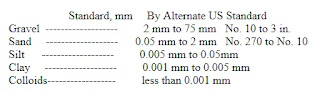SOILS - General Information
Definition:
The term soil as used by engineers, refers to the unconsolidated mineral
material at or near the earths surface, including the air, moisture,
organic matter, and other substances which may incorporate therein which
have resulted from natural processes, such as weathering, decay and
chemical action. From engineering point of view, soil is distinguished from
a sound rock by this simple tests. If an air dried soil is immersed in
water, it will disintegrate after a short time; a sound rock will remain
intact if treated similarly.
Soil are grouped into three major divisions; granular soils which include
sand and gravel; fine grained soils which include silts and clay and
organic soils which include muck, peat or organic silts. The most widely
used grouping of soils according to particle size are the following.
Standard, mm By Alternate US Standard
Gravel ------------------- 2 mm to 75 mm No. 10 to 3 in.
Sand ------------------- 0.05 mm to 2 mm No. 270 to No. 10
Silt ------------------- 0.005 mm to 0.05mm
Clay ------------------- 0.001 mm to 0.005 mm
Colloids------------------ less than 0.001 mm
Engineering Properties
Granular Soils:
- Good load bearing qualities.
- Permeable, hence they drain readily.
- Comparatively incompressible when subjected to static loads.
- Not subject to changes in strength or volume due to variation in water content. However, loose granular materials will undergo considerable reduction in volume if subjected to vibratory loads.
Fine-Grained Soils:
- Poor load - sustaining qualities.
- Highly impermeable.
- Compressible under sustained load.
- Subject to changes in volume and strength due to variation in water content.
Organic Soils:
Inferior than fine-grained soils with respect to the properties stated under the later group.
Identification - Visual and by Texture
- Gravel
Rounded or water-worn pebbles. No cohesion or plasticity. Crunchy under foot. - Sand
Gritty and loose grains. Individual grains readily seen and felt. No plasticity or cohesion. If dry, a cast formed in the hand will fall apart; if moist, a cast will crumble when touched.
- Silt
Fine and barely visible grains. When in a dry pulverized condition, it feels soft and floury. Can hardly be made plastic. Exhibits little or no strength when air-dried. A dried cast is easily crushed in the hands.
In the wet state, an organic silt can be rolled into thin threads, but if the threads are more than a few inches long, they will not support their own weight if held by one end.
When mixed with water to the consistency of a thick paste, the surface of an inorganic silt, will appear wet and shiny if a pat is shaken in the palm of the hand; if the pat is squeezed, the surface will dry up, appear dry, and eventually crack. Clay, if treated similarly will not change in appearance.
- Clay
Can be made plastic by adjusting its water content. Cohesive. Exhibits considerable strength when dried; difficult or impossible to crush in hands.
Clay can be molded and rolled into thin threads without breaking or crumbling within a moderate to a wide range in water content, and threads of considerable length will support their own weight when held by one end. - Organic Soils
gray to black color. Fibrous structure due to presence of undecomposed plant matter. unhealthy sewage-sludge odor. Found as deposits in swamps and peat bogs.




Post a Comment